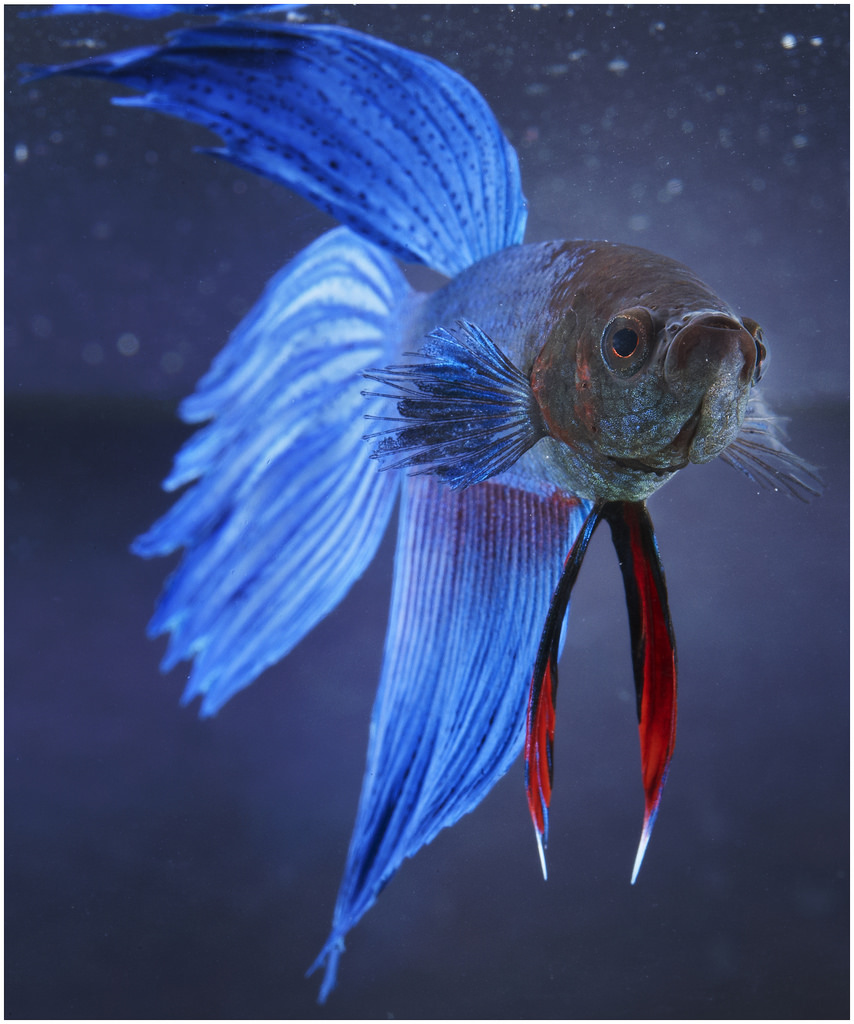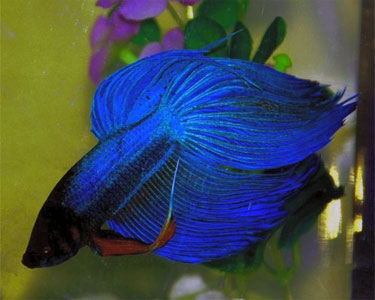Betta fish, also known as Siamese fighting fish, is a tough fish that is very easy to maintain and can live upwards of three years, provided that you care for it properly. Provide this betta fish with everything it needs to live a healthy life, and it will stay vibrant, colorfully sharp and happy for a very long time.
A Little Bit About The Betta
Bettas, (also known by their Latin name Betta Splendens), are originally from the muddy streams, ponds, and rice paddies of Thailand and Cambodia. The original bettas had dull coloring and short fins.
But bettas of today have long flowy fins and they come in all sorts of sharp colors, mainly because of genetic mutations and breeding. Their long fins are a primarily a unique feature of the male betta. Female bettas are, generally speaking, have shorter fins and are a bit smaller in size.
Another trait that sets male bettas apart is their aggressiveness. Male bettas are more aggressive than female bettas (like most males of most species, including human males), therefore you should not keep two of them in contact together where they will fight each other until one of them is dead.

Some interesting betta fish facts
- The name of Betta was referred to an ancient clan of warriors, called the “Bettah”.
- The Betta fish genus consists of more than 70 different species.
- A Betta of may fight even with it’s own reflection.
- Bettas prefer to swim alone and also need a comfortable place to hide.
- They normally live between 2 and 3 years.
- They can live without eating for up to two weeks.
- They are carnivores…the male can eat even it’s own offspring, but the males can also take charge of caring for their little ones.
- Frozen brine shrimp ice cubes is their favorite food. (They love it!)
- The rich colors of a Betta fish are due to selective breeding.
- They can also survive outside water for several hours at a time. (Although, it’s not recommended)
- Male Bettas build bubble nests for mating and to protect the eggs.
- Bettas are very intelligent and have the ability to recognizes their owners.
- The brighter the colours of their fins the healthier they are.
How to House and Maintain a Betta
You don’t really need to buy a filter but if you do use one, make sure the filter flow is on a low setting as Bettas don’t like a lot of agitation in the water. You also have to take precautions against your bettas getting their fins stuck in the filter intake.
Bettas also love a good hiding spot. So try to get some plants or little cave decorations. Old coffee mugs can also work. Make sure the fake plants are not a hard plastic in order to avoid fin damage. Large leafed silky plants are ideal.
Water changes: An unfiltered tank needs 50% water change once every week. A larger (5+ gallons) tank, that has a filter may only need 20-30% change once a week. Ammonia is produced from fish waste which is harmful even in small quantity so it’s very important to use a water conditioner after you add water to your Betta’s tank.
The conditioner also removes toxins from tap water that can be a cause of death for your fish. Add some gravel at the bottom to keep waste from floating around the bowl. It prevents the bacteria from growing and also looks very nice! Also make sure that the water you are adding to the tank is the around the same temperature as in the tank to avoid shocking your betta.
Best to keep the water in a container for some time near the fish tank and then pour it in slowly to avoid stressing the fish. If you do remove your betta from the tank when changing water, let it float in a cup for about 10 minutes before releasing it into the tank.
Feeding: Bettas are carnivorous, so use pellets that are high in meat based ingredients like fish or shrimp. Frozen bloodworms, brine shrimp, or glass worms are some of the popular Betta foods.
Don’t overfeed your betta otherwise you will cause it to be obese, which will result in a messy tank. Just feed them no more than 2-3 pellets twice a day. One pellet 3 times a day is ideal. Also remove any uneaten food daily because the pellets swell in water and can clog up the filter.
 So as you can see, taking care of your Betta fish is not that difficult as long as you follow the proper guidelines. However, there may be times when you might have to deal with a sick Betta.
So as you can see, taking care of your Betta fish is not that difficult as long as you follow the proper guidelines. However, there may be times when you might have to deal with a sick Betta.
Here are a few signs that can indicate your Betta is not well:
- It start swimming in a strange pattern
- It’s constantly coming to the top of the tank gasping for air
- The Betta is spending too much time hiding at the bottom of the tank
- It does not eat and white spots have developed all over it’s body
- It’s rubbing itself against plants or other ornaments
How to Prevent Your Betta from Getting Sick
As mentioned earlier in this post, poor water quality can cause the Betta to be sick and the bacteria in the tank can cause fin rot in the fishes. Fluctuating water temperatures are also a major cause of sickness. If you keep up with regular water changes and ensure constant water temps, then the chances of your fish getting sick is low.
But if your Betta fish gets sick there are a few things you can do…
If your fish is showing signs of fungus infection (white, cotton-like patches on the body) then add a bit of Jungle fungus eliminator (35 grams per half gallon). Keep changing the water every few days and adding the above medicine. You should also add aquarium salt to a new water change to keep the water quality healthy. If you notice fin rot Maracyn-2 or MelaFix in addition to aquarium salt.
Remember; anytime your fish shows abnormal behaviour or unusual signs, do a 100% water change, clean the tank (vacuuming gravel) and give them quality, nutritious food.
In Conclusion…
Caring for a Betta fish is not difficult once you have a system down and have all the essential information. Monitor the fish’s health daily, weekly, and monthly and watch for any indicators of bad health. Common issues outlined above are fin rot, swim bladder problems, fungal and not moving due to lethargy.
Most of these issues can be solved with proper feeding and tank maintenance. Your Betta fish needs the right care from to live a long and healthy life. If you have any questions, or have a Betta fish that looks sick; comment in the section below.



























